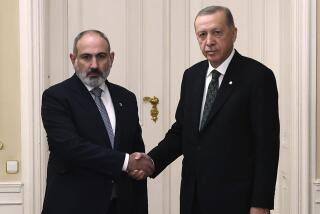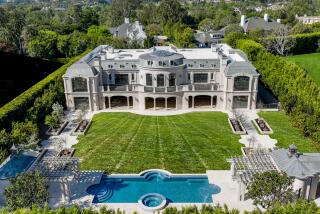Aid for Devastated Lebanese Armenians Sought : Fund raising: The leader of an arm of the Apostolic Church is in the Southland seeking help for his people.
The spiritual leader of one arm of the Armenian Apostolic Church came to Southern California this week to highlight the devastation of his community in Lebanon and to ask local Armenians for their help.
Karekin II said the situation in East Beirut, where the Armenian Apostolic Church of Cilicia is based, has been overshadowed by ethnic unrest in the Soviet Union and by the earthquake that struck Soviet Armenia in 1988.
Thousands of people in the Armenian community have been caught in the cross-fire of the Lebanese civil war, the patriarch said, though not many people know about their struggle. âIn the last four months things have become so tragic that people in the United States must be made aware of the situation,â he said. âWe have reached a stage of crisis.â
Although Karekin II did not say how much money he hoped to raise during his American visit, a report issued by the Armenian prelacy of Lebanon said about $600,000 a month is needed to help the Armenian families most severely affected by the shelling. The same report said about 30 Armenians have died in the last three months as a result of the fighting. There are about 175,000 Armenians in Lebanon.
âThere is scarcity of food, most of the homes have been damaged significantly, there is no electricity, no running water, schools have closed and businesses have been disrupted,â the 58-year-old patriarch said during an interview.
Karekin II, who is the highest Armenian Church official outside of the Soviet Union, began his five-day trip Tuesday with prayers and an address to about 400 Armenians at St. Garabed Armenian Church in Hollywood. Dressed in traditional black and purple robes, he also visited churches in Encino and Montebello and will end his West Coast tour Sunday with a Holy Mass at St. Maryâs Armenian Church in Glendale. Most of Southern Californiaâs estimated 300,000 Armenians live in Hollywood, Glendale and Pasadena.
âHis Holinessâ visit is very important to Armenians here,â said Berdj Karapetian, executive director of the Armenian National Committee, an umbrella group for the community. âFor Armenians the church is not just a religion. It is a national church. It is how Armenian people identify as Armenians.â
The Armenian Church claims about 7 million members worldwide. Most Armenians fled their native homeland, present-day Eastern Turkey, after a massacre by the Turks in 1915. Diaspora Armenians live in Soviet Armenia, the Middle East, Europe, the United States and Canada.
Karekin II said that despite Soviet President Mikhail S. Gorbachevâs policy of restructuring, commonly known as perestroika , the flow of immigrants from the Soviet Union to the United States is expected to continue at the present level of between 10,000 to 15,000 people a year--90% of whom settle in Southern California.
The church, for its part, discourages immigration. âIt is not only hardship why people are leaving,â he said. âIt is the American way of life that leads them here.
âI tell them they have to stay and accept the challenge,â the prelate continued. âWe are in our motherland and we have a chance to be masters of our own life and to reach our aspiration of freedom and independence.â
Karekin II said that although the plight of Armenians in Lebanon is his top priority during this visit, other issues, including ethnic violence in the Soviet republics of Azerbaijan and Armenia are of great concern to the church.
For the last 2 1/2 years most of the violence in that region has been in the enclave of Nagorno-Karabagh, which has a majority population of Armenian Christians, but is under the administrative control of Muslim Azerbaijanis. Several hundred people have died in clashes over the disputed territory since February, 1988, when massive Armenian demonstrations demanding an end to Azerbaijani control of Nagorno-Karabagh were answered by violent counterdemonstrations in Azerbaijan.
When Gorbachev came to the United States last month for summit talks, he was trailed by Armenian demonstrators demanding that he take more action to help Armenians in Nagorno-Karabagh obtain self-rule.
Although the Armenian Church is considered a single entity, it has been divided by geographic jurisdictions and political differences for the last 35 years. But the suffering of the Armenian people has brought an end to the internecine conflict, Karekin II said. He recently reconciled with Catholicos Vazken I, head of the Holy See of Etchmiadzin in Soviet Armenia, known as the Catholicos of All Armenians.
The two religious leaders of the Armenian Church have met several times in the last five years. Most recently, they each signed a letter to U.N. Secretary-General Javier Perez de Cuellar calling for a recognition of the âlegitimate rights of the Armenian people.â Last month the two leaders jointly consecrated a new Armenian Church in Belgium.
âWe realized that we have higher goals which are more important than our differences,â Karekin II said. âWe can not act separately. We have entered a new line of policy to work together. We have to face challenges as one church and one nation.â
Karekin II also discussed new religious freedoms in the Soviet Union brought about by glasnost . The pontiff said that after years of religious persecution, Armenians are rediscovering their religion. Thousands of Armenian churches have reopened in the Soviet Union, and 26 ancient churches have reopened in Soviet Armenia, the patriarch said.
More to Read
Sign up for Essential California
The most important California stories and recommendations in your inbox every morning.
You may occasionally receive promotional content from the Los Angeles Times.










